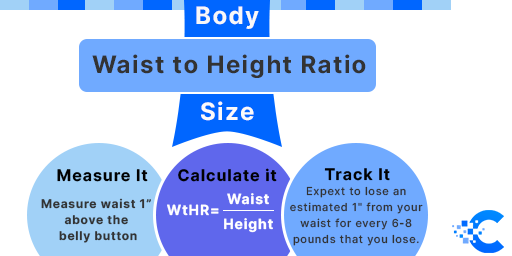If you are interested in calculating the height to waist ratio, you can now get this information with our waist to height ratio calculator. The calculator works on the principle of a simple and effective display of obesity or some other serious risk to your health. Find out below what this indicator represents and how it is measured.
What is the waist-height ratio?
It is necessary to answer at the beginning what precisely this indicator means. It is called the waist-to-height ratio and indicates the potential risks of obesity, diabetes, heart disease, and even stroke. It is essential to distinguish it from the WHR indicator because it is used to measure body mass distribution. The bottom line is that you can use both indicators to check for possible health problems. Each of these measures has its link to some of the health conditions. The waist ratio can be associated with the risk of developing heart disease, as it measures the percentage of visceral fat that can directly affect the occurrence of stroke. To the extent that a larger waist circumference was recorded, the mortality rate was higher than the stated health problems. This indicator can be used when measuring the waist-to-height ratio (WHtR) regardless of age (whether children or adults), but you should note that specific parameters can impact and vary on the final result of the ratio.
Why is the waist-height ratio important?
The importance of knowing this type of indicator lies in the fact that it offers us an insight into the risks of various health problems and diseases. Since this indicator measures the distribution of body weight in your body, we can relate this directly to the possibility of obesity. Various studies have also shown that the height-to-waist ratio in individual subjects is an excellent indicator of the risk of death or related cases. Other related indicators are body mass index (BMI) and waist-to-hip ratio. Specific limit values have been set concerning statistical data that apply to the male part of the population (0.50) and the female part of the population (0.50).
How to measure your waist?
There are specific instructions and steps on correctly measuring your waist ratio. This process is straightforward and straightforward, and all you need is one measuring tape.
- It is necessary to start first from the top of the hip bone, and pass the tape around the body and align it with the navel without holding your breath while lightly keeping the measuring tape without excessive pressure on the skin
- After that, it is enough to exhale normally and look at and record the number from the measuring tape

Best waist-to-height ratio?
In answering this question, we will look at that there are different body shapes, and each body is unique. There are no two identical body shapes in the world, which leads to the conclusion that it is not the essence of having the best ratio of waist and height, but what impact it has on our overall health. These numbers should not define and influence our views in terms of appearance, but to be more aware of our predispositions to create specific health problems. As for the best waist-to-height ratio, there are certain limits that, if crossed, can increase the propensity for various health problems.

What does the waist-to-height ratio calculator show us?
The purpose of creating a waist-to-height ratio calculator is to get the desired results in a brief period in an easier and faster way by entering data for each item individually. The ratio is obtained by relating the ratio of the waist as the numerator and the ratio of height as the denominator expressed in centimeters or inches.
Waist \; to \; Height \; Ratio = \frac{Waist \; Circumference}{Height}
WHtR = \frac{W}{H}
What is the most attractive waist size?
What is meant by an attractive waist size? According to theorists, the mean 0.7 should be the most beautiful. This is directly related to the WHR indicator, which can be applied individually to the female and male populations. In theory, the female part of the population has a lower WHR indicators value than men. Accordingly, the ideal waist-to-hip ratio (WHR) ranges between 0.65 and 0.80 for healthy females, while it is somewhat different for men. And when it comes to health, the most attractive waist size should be under 40 inches for men and under 35 inches for women. When we mention attractiveness, we can link the most attractive body shape in the female population, called an hourglass, characterized by a meager ratio of waist and hips. In men, the most attractive form is the inverted pyramid, recognizable by its broad shoulders and tiny waist.
